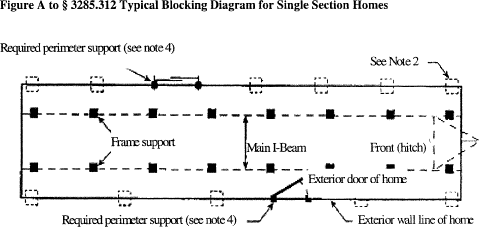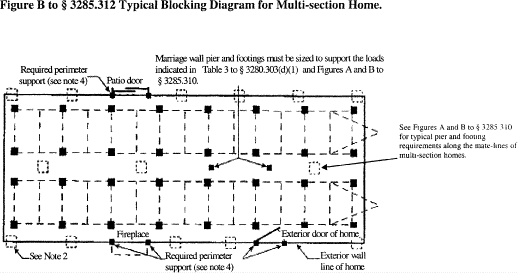Title 24
SECTION 3285.312
3285.312 Footings.
§ 3285.312 Footings.(a) Materials approved for footings must provide equal load-bearing capacity and resistance to decay, as required by this section. Footings must be placed on undisturbed soil or fill compacted to 90 percent of maximum relative density. A footing must support every pier. Footings are to be either:
(1) Concrete.
(i) Four inch nominal precast concrete pads meeting or exceeding ASTM C 90-02a, Standard Specification for Loadbearing Concrete Masonry Units (incorporated by reference, see § 3285.4), without reinforcement, with at least a 28-day compressive strength of 1,200 pounds per square inch (psi); or
(ii) Six inch minimum poured-in-place concrete pads, slabs, or ribbons with at least a 28-day compressive strength of 3,000 pounds per square inch (psi). Site-specific soil conditions or design load requirements may also require the use of reinforcing steel in cast-in-place concrete footings.
(2) Pressure-treated wood.
(i) Pressure-treated wood footings must consist of a minimum of two layers of nominal 2-inch thick pressure-treated wood, a single layer of nominal 3/4-inch thick, pressure-treated plywood with a maximum size of 16 inches by 16 inches, or at least two layers of 3/4-inch thick, pressure-treated plywood for sizes greater than 16 inches by 16 inches. Plywood used for this purpose is to be rated exposure 1 or exterior sheathing, in accordance with PS1-95, Construction and Industrial Plywood (incorporated by reference, see § 3285.4).
(ii) Pressure treated lumber is to be treated with a water-borne adhesive, in accordance with AWPA Standard U1-04 (incorporated by reference, see § 3285.4) for Use Category 4B ground contact applications.
(iii) Cut ends of pressure treated lumber must be field-treated, in accordance with AWPA Standard M4-02 (incorporated by reference, see § 3285.4).
(3) ABS footing pads.
(i) ABS footing pads are permitted, provided they are installed in accordance with the pad manufacturer installation instructions and certified for use in the soil classification at the site.
(ii) ABS footing pads must be listed or labeled for the required load capacity.
(4) Other Materials. Footings may be of other materials than those identified in this section, provided they are listed for such use and meet all other applicable requirements of this subpart.
(b) Placement in freezing climates. Footings placed in freezing climates must be designed using methods and practices that prevent the effects of frost heave by one of the following methods:
(1) Conventional footings. Conventional footings must be placed below the frost line depth for the site unless an insulated foundation or monolithic slab is used (refer to §§ 3285.312(b)(2) and 3285.312(b)(3)). When the frost line depth is not available from the LAHJ, a registered professional engineer, registered architect, or registered geologist must be consulted to determine the required frost line depth for the manufactured home site. This is not subject to the provisions in § 3285.2(c) that also require review by the manufacturer and approval by its DAPIA for any variations to the manufacturer's installation instructions for support and anchoring.
(2) Monolithic slab systems. A monolithic slab is permitted above the frost line when all relevant site-specific conditions, including soil characteristics, site preparation, ventilation, and insulative properties of the under floor enclosure, are considered and anchorage requirements are accommodated as set out in § 3285.401. The monolithic slab system must be designed by a registered professional engineer or registered architect:
(i) In accordance with acceptable engineering practice to prevent the effects of frost heave; or
(ii) In accordance with SEI/ASCE 32-01 (incorporated by reference, see § 3285.4).
(3) Insulated foundations. An insulated foundation is permitted above the frost line, when all relevant site-specific conditions, including soil characteristics, site preparation, ventilation, and insulative properties of the under floor enclosure, are considered, and the foundation is designed by a registered professional engineer or registered architect:
(i) In accordance with acceptable engineering practice to prevent the effects of frost heave; or
(ii) In accordance with SEI/ASCE 32-01 (incorporated by reference, see § 3285.4).
(c) Sizing of footings. The sizing and layout of footings depends on the load-bearing capacity of the soil, footings, and the piers. See §§ 3285.202 and 3285.303, and Table to 3285.312.
 Notes:
Notes:
1. Refer to Table 1 of § 3285.303 for pier and footing requirements when frame blocking only is used.
2. In addition to blocking required by § 3285.311, see Table 2 to § 3285.303 for maximum perimeter blocking loads.
3. End piers under main I-beams may be set back a maximum of 24 inches, as measured from the outside edge of the floor to the center of the pier.
4. Place piers on both sides of sidewall exterior doors, patio doors, and sliding glass doors; under porch posts, factory-installed fireplaces, and fireplace stoves; under jamb studs at multiple window openings; and at any other sidewall openings 48 inches or greater in width. For roof loads of 40 psf or greater, a professional engineer or registered architect must determine the maximum sidewall opening permitted without perimeter supports. See §§ 3285.307 and 3285.311 for additional requirements and for locating perimeter supports.
 Notes:
Notes:
1. Refer to Table 1 to § 3285.303 for pier and footing requirements when frame blocking only is used.
2. In addition to blocking required by § 3285.311, see Tables 2 and 3 to § 3285.303 for maximum perimeter blocking loads.
3. End piers under main I-beams may be set back a maximum of 24 inches, as measured from the outside edge of the floor to the center of the pier.
4. Place piers on both sides of sidewall exterior doors, patio doors, and sliding glass doors; under porch posts, factory-installed fireplaces, and fireplace stoves; under jamb studs at multiple window openings; and at any other sidewall openings of 48 inches or greater in width. For roof loads of 40 psf or greater, a professional engineer or registered architect must determine the maximum side wall opening permitted without perimeter supports or mating wall opening permitted without pier or other supports. See §§ 3285.307 and 3285.311 for additional information on requirements and for locating perimeter supports.
5. When an end pier under the mate-line also serves as a column pier, it may be set back a maximum of 6 in., as measured from the inside edge of the exterior wall to the center of the pier.
Table to § 3285.312 - The Size and Capacity for Unreinforced Cast-in-Place Footings
| Soil capacity (psf) |
Minimum footing
size (in.) |
8 in. × 16 in. pier | 16 in. × 16 in. pier | ||
|---|---|---|---|---|---|
| Maximum footing capacity (lbs.) |
Unreinforced cast-in-place
minimum thickness (in.) |
Maximum footing capacity (lbs.) |
Unreinforced cast-in-place
minimum thickness (in.) |
||
| 1,000 | 16 × 16 | 1,600 | 6 | 1,600 | 6 |
| 20 × 20 | 2,600 | 6 | 2,600 | 6 | |
| 24 × 24 | 3,700 | 6 | 3,700 | 6 | |
| 30 × 30 | 5,600 | 8 | 5,800 | 6 | |
| 36 × 36 | 7,900 | 10 | 8,100 | 8 | |
| 42 × 42 | 4 10,700 | 10 | 10,700 | 10 | |
| 48 × 48 | 4 13,100 | 12 | 13,600 | 10 | |
| 1,500 | 16 × 16 | 2,500 | 6 | 2,500 | 6 |
| 20 × 20 | 4,000 | 6 | 4,000 | 6 | |
| 24 × 24 | 5,600 | 8 | 5,700 | 6 | |
| 30 × 30 | 4 8,500 | 10 | 8,900 | 8 | |
| 36 × 36 | 4 12,400 | 10 | 12,600 | 8 | |
| 42 × 42 | 4 16,500 | 12 | 416,800 | 10 | |
| 48 × 48 | 4 21,200 | 14 | 421,600 | 12 | |
| 2,000 | 16 × 16 | 3,400 | 6 | 3,400 | 6 |
| 20 × 20 | 5,300 | 6 | 5,300 | 6 | |
| 24 × 24 | 7,600 | 8 | 7,700 | 6 | |
| 30 × 30 | 4 11,700 | 10 | 11,900 | 8 | |
| 36 × 36 | 4 16,700 | 15 | 4 16,900 | 10 | |
| 42 × 42 | 4 21,700 | 18 | 4 22,700 | 12 | |
| 2,500 | 16 × 16 | 4,300 | 6 | 4,300 | 6 |
| 20 × 20 | 6,700 | 6 | 6,700 | 6 | |
| 24 × 24 | 4 9,600 | 8 | 9,700 | 6 | |
| 30 × 30 | 4 14,800 | 10 | 15,000 | 8 | |
| 36 × 36 | 4 20,700 | 12 | 4 21,400 | 10 | |
| 3,000 | 16 × 16 | 5,200 | 6 | 5,200 | 6 |
| 20 × 20 | 8,100 | 8 | 8,100 | 6 | |
| 24 × 24 | 4 11,500 | 10 | 11,700 | 6 | |
| 30 × 30 | 4 17,800 | 12 | 4 18,100 | 8 | |
| 36 × 36 | 4 25,400 | 14 | 4 25,900 | 10 | |
| 4,000 | 16 × 16 | 7,000 | 6 | 7,000 | 6 |
| 20 × 20 | 4 10,800 | 8 | 10,900 | 6 | |
| 24 × 24 | 4 15,500 | 10 | 15,600 | 8 | |
| 30 × 30 | 4 23,300 | 12 | 4 24,200 | 10 | |
1. The footing sizes shown are for square pads and are based on the area (in. 2), shear and bending required for the loads shown. Other configurations, such as rectangular or circular configurations, can be used, provided the area and depth is equal to or greater than the area and depth of the square footing shown in the table, and the distance from the edge of the pier to the edge of the footing is not less than the thickness of the footing.
2. The 6 in. cast-in-place values can be used for 4 in. unreinforced precast concrete footings.
3. The capacity values listed have been reduced by the dead load of the concrete footing.
4. Concrete block piers must not exceed their design capacity of 8,000 lbs. for 8″ × 16″ single stack block and 16,000 lbs. for 16″ × 16″ double stack block.
5. A registered professional engineer or registered architect must prepare the design, if the design loads exceed the capacity for single or double stack concrete block piers shown in footnote 4.